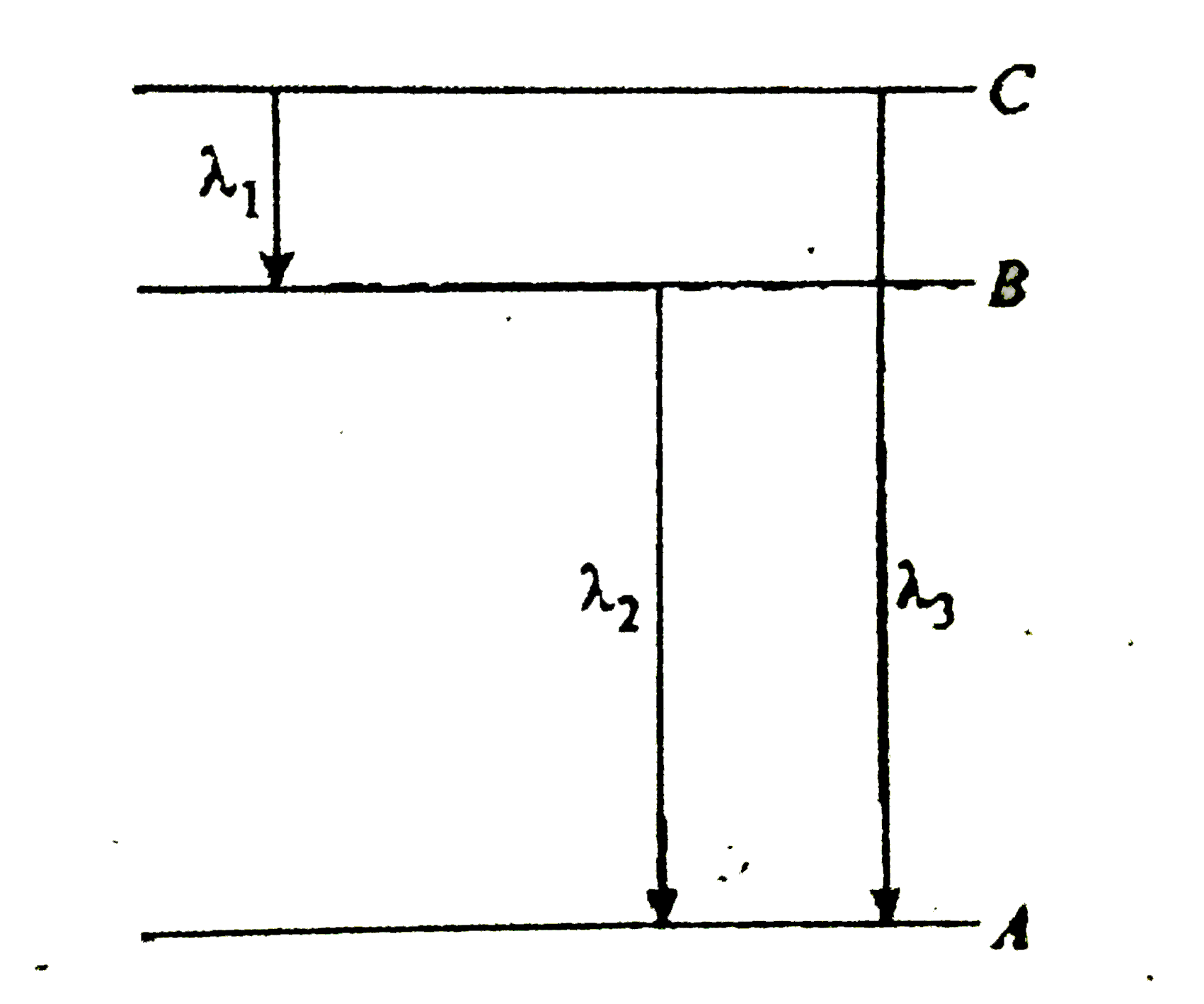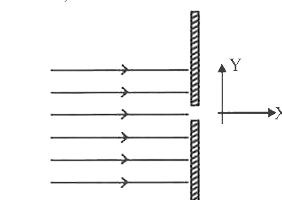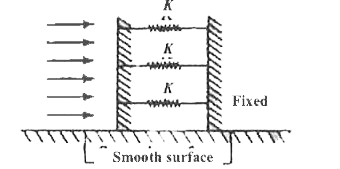Complete Solutions to EXERCISE -2 : CONCEPT ALLPLICATOR of chapter DUAL NATURE OF RADIATION AND MATTER of Class 12 book with complete answers and questions
| Class 12 | PHYSICS |
| Chapter | DUAL NATURE OF RADIATION AND MATTER |
| DISHA PUBLICATION | EXERCISE -2 : CONCEPT ALLPLICATOR |
| Number Of Questions | 30 |
| Academic Year | 2023-24 |
When photon of wavelength `lambda_(1)` are incident on an isolated shere supended by an insulated , the corresponding stopping potential is found to be `V`. When photon of wavelength `lambda_(2)` are used , the orresponding stopping potential was thrice the above value. If light of wavelength `lambda_(3)` is used , carculate the stopping potential for this case.
View SolutionA photosensitive metallic surface has work funtion `hv_(0)`. If photons of energy `2hv_(0)` fall on this surface the electrons come out with a maximum velocity of `4xx10^(6) m//s`. When the photon energy is increases to `5hv_(0)` then maximum velocity of photo electron will be
View SolutionA `5 W` source emits monochromatic light of wavelength `5000 Å`. When placed `0.5 m` away , it liberates photoelectrons from a photosensitive metallic surface . When the source is moved to a distance of `1.0 m` the number of photoelectrons liberated will be reduced by a factor of
View SolutionWhen a certain metallic surface is illuminated with monochromatic light of wavelength `lamda`, the stopping potential for photoelectric current is `3V_0` and when the same surface is illuminated with light of wavelength `2lamda`, the stopping potential is `V_0`. The threshold wavelength of this surface for photoelectrice effect is
View SolutionLight from a hydrogen tube is incident on the cathode of a photoelectric cell the work function of the cathode surface is `4.2 eV`. In order to reduce the photo - current to zero the voltage of the anode relative to the cathode must be made
View SolutionElectron are accelerated through a potential difference V and protons are accelerated through a potential difference of 4 V. The de-Broglie wavelength are `lamda_e and lamda_p` for electrons and protons, respectively The ratio of `lamda_e/lamda_p` is given by ( given , `m_e` is mass of electron and `m_p` is mass of proton )
View SolutionA metal surface is illuminated by light of two different wavelengths 248 nm and 310 nm. The maximum speeds of the photoelectrons corresponding to these wavelengths are `mu_1` and `mu_2` respectively. If the ratio `u_1: u_2 = 2:1 and hc= 1240 eV` , the work function of the metal is nearly.
(a)3.7 eV (b) 3.2 eV
(c ) 2.8eV (d) 2.5eV.
View SolutionA beam of light has three wavelengths `4144 Å`, `4972 Å` and `6216 Å` with a total instensity of `3.6 xx 10^(-3) Wm^(-2)` equally distributed amongst the three wavelengths. The beam falls normally on an area `1.0 cm^2` of a clean metallic surface of work function 2.3 eV. Assume that there is no loss of light by reflection and that each energetically capable photon ejects on electron. Calculate the number of photo electrons liberated in two seconds.
View SolutionEnergy levels A,B and C of a certain atom correspond to increasing values of energy i.e. `E_(A) lt E_(B) lt E_(C)` .If `lamda_(1),lamda_(2),lamda_(3)` are the wavelengths of radiation corresponding to transition C to B,B to A and C to A respectively, which of the following statements is correct ?

View SolutionA copper ball of radius 1 cm and work function 4.47eV is irradiated with ultraviolet radiation of wavelength 2500 Å. The effect of irradiation results in the emission of electrons from the ball, Further the ball will acquire charge and due to this there will be a finite value of the potential on the ball. The charge acquired by the ball is :
View SolutionA parallel beam of electrons travelling in x-direction falls on a slit of width d (see figure). If after passing the slit, an electron acquires momentum `p_y` in the y-direction then for a majority of electrons passing through the slit (h is Planck's constant):

View SolutionLight of wavelength `0.6mum` from a sodium lamp falls on a photocell and causes the emission of photoelectrons for which the stopping potential is 0.5V. With light of wavelength `0.4mum` from a murcury vapor lamp, the stopping potential is `1.5V`. Then, the work function [in electron volts] of the photocell surface is
View SolutionAn electron is accelerated through a potential difference of V volt. It has a wavelength `lambda` associated with it. Through what potential difference an electron must be accelerated so that its de Broglie wavelength is the same as that of a proton? Take massof proton to be 1837 times larger than the mass of electron
View SolutionIn a photoelectric emission, electrons are ejected from metals X and Y by light of frequency f. The potential difference V required to stop the electrons is measured for various frequencies. If Y has a greater work function than X, which graph illustrates the expected results.
View SolutionA homogeneous ball (mass=m) of ideal black material at rest is illuminated with a radiation having a set of photons (wavelength`=lamda`), each with the same momentum and the same energy. The rate at whoch photons fall on the ball is n. the linear acceleration of the ball is
View SolutionLight of wavelength `lamda` from a small 0.5 mW He-Ne laser source, used in the school laboratory, shines from a spacecraft of mass 1000 kg. Estimate the time needed for the spacecraft to reach a velocity of `1.0km^(-1)` from rest. The momentum p of a photon of wavelength `lamda` is given by `p=(h)/(lamda)`, where h is Planck's constant.
View SolutionA photon and an electron posses same de-Broglie wavelength. Given that c= speed of light and v=speed of electron, which of the following relations is correct? Here `E_(e) = KE` of elecron, `E_(ph) = KE` of photon, `p_(e) = momentum of electron , `p_(ph)` = momentum of photon:
View SolutionLight of intensity I is incident perpendicularly on a perfectly reflecting plate of area A kept in a gravity free space. If the photons strike the plate symmetrically and initially the spring was at its natural length, find the maximum compression in the springs.

View SolutionWhat will be the ratio of de - Broglie wavelengths of proton and `alpha` - particle of same energy ?
View SolutionA sensor is exposed for time t to a lamp of power P placed at a distance l. The sensor has an opening that is 4d in diameter. Assuming all energy of the lamp is given off as light, the number of photons entering the sensor if the wavelength of light is `lambda` is:
View SolutionWhen X- ray of wavelength 0.5 Å pass through 7 mm thick aluminium sheet then their intensity reduces to one fourth. Find coefficient of absorbtion of aluminium for these X-rays.
View SolutionA source `S_(1)` is producing `10^(15)` photons/s of wavelength `5000 Å` Another source `S_(2)` is producing `1.02 xx 10^(15)` photons per second of wavelength `5100 Å`. Then `("power of" `S_(2))/("power of" S_(1))` is equal to
View SolutionThe potential difference that must be applied to stop the fastest photoelectrons emitted by a nickel surface , having work function `5.01 eV` , when ultraviolet light of `200 nm` falls on it , must be
View SolutionIf the momentum of electron is changed by `P_(m)` then the de-Broglie wavelength associated with it changes by 0.50%. The initial momentum of electron will be:
View SolutionTwo radiations of photons energies 1 eV and 2.5 eV, successively illuminate a photosensitive metallic surface of work function 0.5 eV. The ratio of the maximum speeds of the emitted electrons is
View SolutionA modern 200 W sodium street lamp emits yellow light of wavelength 0.6 `mum`. Assuming it to be 25% efficient in converting electrical energy to light, the number of photons of yellow light it emits per second is
View SolutionWhen the energy of the incident radiation is increased by 20%, the kinetic energy of the photoelectrons emitted from a metal surface increased from 0.5 eV to 0.8 eV. The work function of the metal is:
View SolutionLight of wavelength `lambda_(A)` and `lambda_(B)` falls on two identical metal plates A and B respectively . The maximum kinetic energy of photoelectrons in `K_(A)` and `K_(B)` respectively , then which one of the following relations is true ? `(lambda_(A) = 2lambda_(B))`
View SolutionAn electron of mass `m` and a photon have same energy `E`. The ratio of de - Broglie wavelengths associated with them is :
View SolutionWhen a metallic surface is illuminated with radiation of wavelength `lambda`, the stopping potential is `V`. If the same surface is illuminated with radiation of wavelength `2 lambda` , the stopping potential is `(V)/(4)`. The threshold wavelength surface is :
View Solution
EXERCISE -2 : CONCEPT ALLPLICATOR questions and complete solutions for chapter DUAL NATURE OF RADIATION AND MATTER of DISHA PUBLICATION PHYSICS (HINGLISH) of Class 12